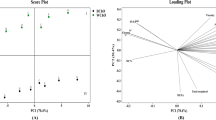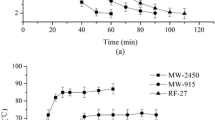Abstract
The effect of microwave heating (800 W) of whole and dehulled rapeseeds for 2 to 8 min was investigated in order to evaluate the impact of dehulling in conjunction with microwaving on the nutritional value, antioxidant activity and physicochemical properties of virgin rapeseed oil. Control oil produced from dehulled seeds (DRO) had higher amounts of bioactive compounds, such as tocochromanols and phytosterols, lower content of pigments, and higher content of primary and secondary oxidation products compared to oil pressed from whole seeds (WRO). Oils pressed from seeds that had previously undergone thermal treatment demonstrated gradual increase of oxidative stability, radical scavenging activity, moreover microwave treatment to caused darkening of oil, assessed in terms of changes in L*a*b* coordinates as well as browning index. Thermally-induced compositional changes were seen mainly in canolol, phytosterols, and carotenoids content, while only slight increase of tocopherols and phenolics was observed. The most pronounced effect of microwave pretreatment was noted for canolol formation—for 8-min MV exposure canolol quantity was approximately 7- and 23-fold higher, in comparison with control WRO and DRO samples, respectively (increase from 61.39 to 456.04 µg/g, and from 13.39 to 320.44 µg/g).

Similar content being viewed by others
Abbreviations
- AHC:
-
Agglomerative cluster analysis
- DRO:
-
Rapeseed oil pressed from dehulled seeds
- HF:
-
Hydrophilic fraction
- IP:
-
Induction period
- LF:
-
Lipophilic fraction
- MV:
-
Microwave
- p-AnV:
-
p-anisidine value
- PC‐8:
-
Plastochromanol‐8
- PV:
-
Peroxide value
- RSC:
-
Radical scavenging activity
- WRO:
-
Rapeseed oil pressed from whole seeds
- α-T:
-
Alpha tocopherol
- β‐T:
-
Beta‐tocopherol
- γ‐T:
-
Gamma‐tocopherol
- δ‐T:
-
Delta‐tocopherol
References
Aachary AA, Thiyam-Holländer U (2013) An update on characterization and bioactivities of sinapic acid derivatives. In: Thiyam-Holländer U, Eskin NAM, Matthäus B (eds) Canola and rapeseed: production, processing, food quality, and nutrition. Taylor & Francis, Boca Raton, pp 21–38
Anders A (2003) Rapeseed coat removal using disks equipped with cylindrical blades. Tech Sci 6:65–72
AOCS Official Method Cc 13d-55 (1997) Determination of chlorophyll related pigments in oil
AOCS Official Method Ch 6-91 (1997) Determination of the composition of the sterol fraction of animal and vegetable oils and fats by TLC and capillary GLC. Champaign, IL
Azadmard-Damirchi S, Habibi-Nodeh F, Hesari J, Nemati M, Achachlouei BF (2010) Effect of pretreatment with microwaves on oxidative stability and nutraceuticals content of oil from rapeseed. Food Chem 121:1211–1215
Azadmard-Damirchi S, Alirezalu K, Achachlouei BF (2011) Microwave pretreatment of seeds to extract high quality vegetable oil. IJIRSE: waset.org/Publication/5056
Brewer MS (2011) Natural antioxidants: sources, compounds, mechanisms of action, and potential applications. Compr Rev Food Sci Food Saf 10:221–247
BSI 684-2.20 (1977) Methods of analysis of fats and fatty oils. Other methods. Determination of carotene in vegetable oils. British Standards Institution, London
Cai L, Cao A, Aisikaer G, Ying T (2013) Influence of kernel roasting on bioactive components and oxidative stability of pine nut oil. Eur J Lipid Sci Technol 115:556–563
Carré P, Quinsac A, Citeau M, Fine F (2015) A re-examination of the technical feasibility and economic viability of rapeseed dehulling. OCL: 10.1051/ocl/2014044
Choe E, Min DB (2006) Mechanisms and factors for edible oil oxidation. Compr Rev Food Sci Food Saf 5:s169–s186
CODEX STAN (2013) Codex standard for named vegetable oils. FAO/WHO, Rome. (CODEX STAN 210-1999)
Dean LL, Davis JP, Sanders TH (2011) Groundnut (Peanut) Oil. In: Gunstone F (ed) Vegetable oils in food technology: composition, properties and uses. Wiley, Chichester, pp 225–242
Durmaz G, Gökmen V (2010) Determination of 5-hydroxymethyl-2-furfural and 2-furfural in oils as indicators of heat pre-treatment. Food Chem 123:912–916
Espin JC, Soler-Rivas C, Wichers HJ (2000) Characterization of the total free radical scavenger capacity of vegetable oils and oil fractions using 2,2-diphenyl-1-picrylhydrazyl radical. J Agric Food Chem 48:648–656
Halvorsen B, Blomhoff R (2011) Determination of lipid oxidation products in vegetable oils and marine omega-3 supplements. Food Nutr Res. doi:10.3402/fnr.v55i0.5792
Hu Z-Y, Hua W, Zhang L, Deng L-B, Liu G-H, Hao W-J (2013) Seed structure characteristics to form ultrahigh oil content in rapeseed. PLoS ONE. doi:10.1371/journal.pone.0062099
ISO 3960 (2005) Animal and vegetable fats and oils. Determination of peroxide value. International Organization for Standardization, Geneva
ISO 6885 (2008) Animal and vegetable fats and oils. Determination of anisidine value. International Organization for Standardization, Geneva
ISO 3656 (2011) Animal and vegetable fats and oils. Determination of ultraviolet absorbance expressed as specific UV extinction. International Organization for Standardization, Geneva
Koski A, Pekkarinen S, Hopia A, Wähälä K, Heinonen M (2003) Processing of rapeseed oil: effects on sinapic acid derivative content and oxidative stability. Eur Food Res Technol 217:110–114
Koubaa M, Mhemdi H, Vorobiev E (2016) Influence of canola seed dehulling on the oil recovery by cold pressing and supercritical CO2 extraction. J Food Eng 182:18–25
Krygier K, Sosulski F, Hogge L (1982) Free, esterified and insoluble phenolic acids II. Composition of phenolic acids in rapeseed flour and hulls. J Agric Food Chem 30:334–336
Maheshwari PN, Stanley DW, Van De Voort FR (1980) Microwave treatment of dehulled rapeseed to inactivate myrosinase and its effect on oil and meal quality. J Am Oil Chem Soc 57:194–199
Matthäus B (2012) Effect of canolol on oxidation of edible oils. In: Thiyam-Holländer U, Eskin NAM, Matthäus B (eds) Canola and rapeseed: production, processing, food quality, and nutrition. Taylor & Francis, Boca Raton, pp 317–328
Mayengbam S, Khattab R, Thiyam-Holländer U (2013) Effect of conventional and microwave toasting on sinapic acid derivatives and canolol content of canola. Curr Nutr Food Sci 9:321–327
Naczk M, Amarowicz R, Sullivan A, Shahidi F (1998) Current research developments on polyphenolics of rapeseed/canola: a review. Food Chem 62:489–502
Rotkiewicz D, Zadernowski R (1997) Rape seeds dehulling. Oilseed Crops 18:493–504
Shrestha K, De Meulenaer B (2014) Effect of seed roasting on canolol, tocopherol, and phospholipid contents, Maillard type reactions, and oxidative stability of mustard and rapeseed oils. J Agric Food Chem 62:5412–5419
Siger A, Kachlicki P, Czubiński J, Polcyn D, Dwiecki K, Nogala-Kałucka M (2014) Isolation and purification of plastochromanol-8 for HPLC quantitative determinations. Eur J Lipid Sci Technol 116:413–422
Siger A, Kaczmarek A, Rudzińska M (2015) Antioxidant activity and phytochemicals content in cold-pressed rapeseed oil obtained from the roasting seeds. Eur J Lipid Sci Technol 117:1225–1237
Spielmeyer A, Wagner A, Jahreis G (2009) Influence of thermal treatment of rapeseed on the canolol content. Food Chem 112:944–948
Tuberoso CIG, Kowalczyk A, Sarritzu E, Cabras P (2007) Determination of antioxidant compounds and antioxidant activity in commercial oilseeds for food use. Food Chem 103:1494–1501
Vaidya B, Choe E (2011) Effects of the seed roasting on tocopherols, carotenoids, and oxidation in mustard seed oil during heating. J Am Oil Chem Soc 88:83–90
Wakamatsu D, Morimura S, Sawa T, Kida K, Nakai C, Maeda H (2005) Isolation, identification, and structure of a potent alkylperoxylradical scavenger in crude canola oil, canolol. Biosci Biotechnol Biochem 68:1568–1574
Wijesundera C, Ceccato C, Fagan P, Shen Z (2008) Seed roasting improves the oxidative stability of canola (B. napus) and mustard (B. juncea) seed oils. Eur J Lipid Sci Technol 110:360–367
Wroniak M, Andres A, Szterk A, Szymczak R (2013) Effect of seed dehulling on sensory and physical-chemical quality and nutritional value of cold-pressed rapeseed oil. Food Sci Technol Qual 5:90–106
Wroniak M, Rękas A, Siger A, Janowicz M (2016) Microwave pretreatment effects on the changes in seeds microstructure, chemical composition and oxidative stability of rapeseed oil. LWT Food Sci Technol 68:634–641
Yang M, Liu Ch, Huang F, Zheng Ch, Zhou Q (2011) Effect of dehulling treatment on the oxidative stability of cold-pressed low erucic acid rapeseed oil. J Am Oil Chem Soc 88:1633–1639
Yang M, Huang F, Liu Ch, Zheng Ch, Zhou Q, Wang H (2013) Influence of microwave treatment of rapeseed on minor components content and oxidative stability of oil. Food Bioproc Tech 6:3206–3216
Yang M, Zheng Ch, Zhou Q, Liu Ch, Li W, Huang F (2014) Influence of Microwaves Treatment of Rapeseed on Phenolic Compounds and Canolol Content. J Agr Food Chem 62:1956–1963
Yoshida H, Takagi S (1997) Effects of seed roasting temperature and time on the quality characteristics of sesame (Sesamum indicum) oil. J Sci Food Agric 75:19–26
Yoshida H, Takagi S, Mitsuhashi S (1999) Tocopherol distribution and oxidative stability of oils prepared from the hypocotyls of soybeans roasted in microwave oven. J Am Oil Chem Soc 76:915–920
Zheng Ch, Yang M, Zhou Q, Liu Ch-S, Huang FH (2014) Changes in the content of canolol and total phenolics, oxidative stability of rapeseed oil during accelerated storage. Eur J Lipid Sci Technol 116:1675–1684
Author information
Authors and Affiliations
Corresponding author
Ethics declarations
Conflict of interest
The authors have declared no conflict of interest.
Rights and permissions
About this article
Cite this article
Rękas, A., Siger, A., Wroniak, M. et al. Dehulling and microwave pretreatment effects on the physicochemical composition and antioxidant capacity of virgin rapeseed oil. J Food Sci Technol 54, 627–638 (2017). https://doi.org/10.1007/s13197-017-2486-y
Revised:
Accepted:
Published:
Issue Date:
DOI: https://doi.org/10.1007/s13197-017-2486-y




